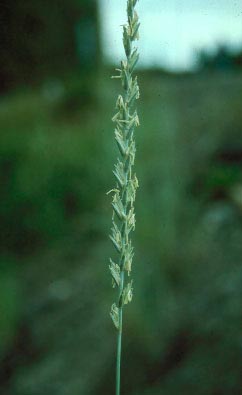Intermediate Wheatgrass

Common Name(s):
Intermediate Wheatgrass
Scientific Name:
Thinopyrum intermedium (Host) Barkworth & D.R. Dewey
Scientific Name Synonyms:
Agropyron intermedium (Host) Beauv.
Elymus hispidus (Opiz) Melderis
Elytrigia intermedia (Host) Nevski
Symbol:
THIN6
Description:
Life Span: Perennial
Origin: Introduced
Season: Cool
Growth Characteristics: A distinctly sod-forming grass, growing 2 ½ to 4 feet tall with abundant rhizomes. It starts growth in early spring, matures June to August. Growth is difficult to maintain during the summer, even with adequate moisture. Reproduces from seeds, tillers, and rhizomes.
Seedhead: Erect spike, 4 to 8 inches long; spikelets slightly overlapping, set close to the rachis, and contain 4 to 8 florets; glumes slightly shorter than the lowest floret when mature and are bluntly pointed; lemmas awnless.
Leaves:Glabrous or somewhat pubescent on blades and sheaths; leaf blades flat, veined, up to 3/8 inch wide and 2 to 6 inches long; leaves rolled in the bud; ligule short, membranous; auricles of medium length and clasping.
Ecological Adaptions:
Intermediate wheatgrass is one of the higher producing introduced grasses on upland and mountain sites. Intermediate wheatgrass has probably not been introduced long enough to become naturalized on any particular set of sites. It is seeded in both dryland and irrigated pastures, as well as in hay meadows. It will grow in 14-inch rainfall belts, but does better with 16 inches or more. Can grow in elevations ranging from 4,000 to 10,000 feet.
Soils: Adapted to well-drained, loamy to fine textured soils that are not more than mildly alkaline.
Associated Species: Pubescent wheatgrass and smooth brome.
Intermediate wheatgrass begins growth moderately early in the spring and remains green longer than most introduced species. It is sufficiently drought tolerant. It is good to excellent forage for all classes of livestock and fair for wildlife. It cures relatively well and remains palatable. It provides excellent cover for upland game birds.
After it is seeded, it takes one or two full growing seasons to become fully established and ready for use.
Responds well to nitrogen fertilization. It produces good to excellent hay if cut early.
Intermediate wheatgrass is one of the better grasses for erosion control because of its vigorous seedlings, quick establishment, and dense root system. It has adapted well to seeding in waterways.

